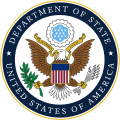| Ambassador of the United States to East Germany | |
|---|---|
 Seal of the United States Department of State | |
| Inaugural holder | Brandon Grove as Chargé d'Affaires |
| Formation | December 9, 1974 |
| Final holder | Richard Clark Barkley |
| Abolished | October 2, 1990 |
The United States had diplomatic relations with the nation of East Germany (the German Democratic Republic) from 1974 to 1990. [1]
Contents
- List of United States ambassadors to East Germany
- Heads of the U.S. Embassy at East Berlin (1974–1990)
- See also
- References
Listed below are the head U.S. diplomatic agents to East Germany, their diplomatic rank, and the effective start and end of their service in East Germany.





